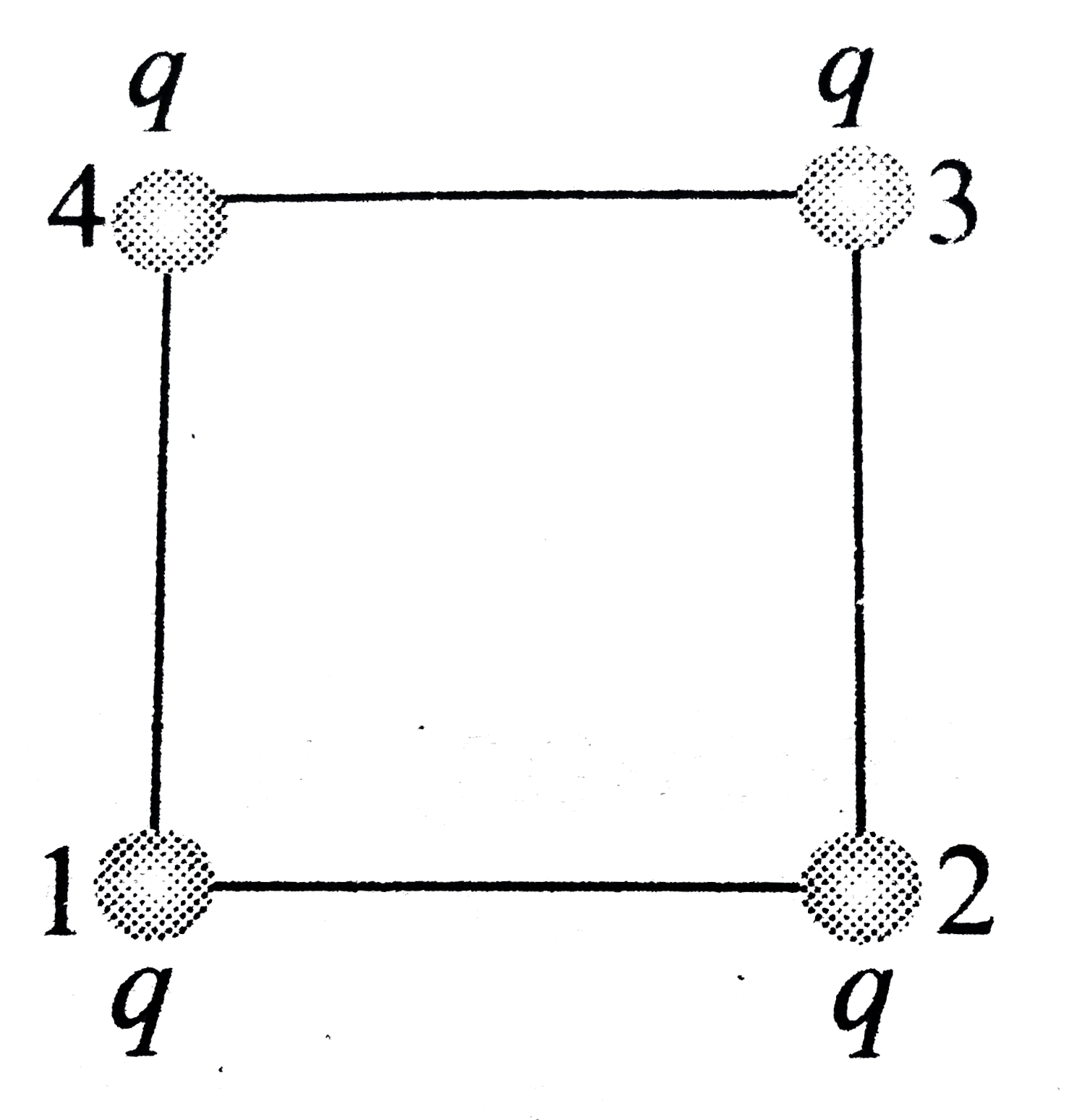Four point charges are respectively placed at the corners A, B, C and D of a square of side a. If F is the mid-point of side CD, the work done in carrying an electron of charge from O [the centre of the square] to F fill be:
qeπε0a(1−1√5)
qeπε0a(1+1√5)
qeπε0a
Zero
The correct Answer is:B
To solve the problem of calculating the work done in carrying an electron from the center of a square to the midpoint of one of its sides, we will follow these steps:
Step 1: Understand the Configuration
We have four point charges placed at the corners of a square ABCD with side length a. Let's denote the charges as follows:
- Charge at A: −Q
- Charge at B: −Q
- Charge at C: +Q
- Charge at D: +Q
The center of the square is denoted as O, and the midpoint of side CD is denoted as F.
Step 2: Calculate the Initial Potential at Point O
The potential V at a point due to a point charge is given by the formula:
V=kQr
where k is Coulomb's constant, Q is the charge, and r is the distance from the charge to the point.
At point O (the center of the square), the distances from O to each of the charges (A, B, C, D) are equal and can be calculated using the Pythagorean theorem:
r=a√2
The potential at O due to each charge is:
- Due to −Q at A: VA=−kQa√2=−√2kQa
- Due to −Q at B: VB=−kQa√2=−√2kQa
- Due to +Q at C: VC=kQa√2=√2kQa
- Due to +Q at D: VD=kQa√2=√2kQa
Adding these potentials together:
VO=VA+VB+VC+VD=−√2kQa+−√2kQa+√2kQa+√2kQa=0
Step 3: Calculate the Potential at Point F
Point F is the midpoint of side CD. The distances from F to the charges at C and D are:
- Distance from F to C: a2
- Distance from F to D: a2
- Distance from F to A: a√2
- Distance from F to B: a√2
The potential at F is:
VF=VC+VD+VA+VB
Calculating each potential:
- VC=kQa2=2kQa
- VD=kQa2=2kQa
- VA=−kQa√2=−√2kQa
- VB=−kQa√2=−√2kQa
Adding these together:
VF=2kQa+2kQa−√2kQa−√2kQa=(4−2√2)kQa
Step 4: Calculate the Work Done
The work done W in moving a charge q from point O to point F is given by:
W=q(VF−VO)
Since VO=0:
W=qVF=q⋅(4−2√2)kQa
For an electron, q=−e:
W=−e⋅(4−2√2)kQa
Final Answer
Thus, the work done in carrying an electron of charge from O to F is:
W=−e(4−2√2)kQa
We have four point charges placed at the corners of a square ABCD with side length a. Let's denote the charges as follows:
- Charge at A: −Q
- Charge at B: −Q
- Charge at C: +Q
- Charge at D: +Q
The potential V at a point due to a point charge is given by the formula:
V=kQr
where k is Coulomb's constant, Q is the charge, and r is the distance from the charge to the point.
r=a√2
- Due to −Q at A: VA=−kQa√2=−√2kQa
- Due to −Q at B: VB=−kQa√2=−√2kQa
- Due to +Q at C: VC=kQa√2=√2kQa
- Due to +Q at D: VD=kQa√2=√2kQa
VO=VA+VB+VC+VD=−√2kQa+−√2kQa+√2kQa+√2kQa=0
Point F is the midpoint of side CD. The distances from F to the charges at C and D are:
- Distance from F to C: a2
- Distance from F to D: a2
- Distance from F to A: a√2
- Distance from F to B: a√2
VF=VC+VD+VA+VB
Calculating each potential:
- VC=kQa2=2kQa
- VD=kQa2=2kQa
- VA=−kQa√2=−√2kQa
- VB=−kQa√2=−√2kQa
VF=2kQa+2kQa−√2kQa−√2kQa=(4−2√2)kQa
The work done W in moving a charge q from point O to point F is given by:
W=q(VF−VO)
Since VO=0:
W=qVF=q⋅(4−2√2)kQa
For an electron, q=−e:
W=−e⋅(4−2√2)kQa
Thus, the work done in carrying an electron of charge from O to F is:
W=−e(4−2√2)kQa
Topper's Solved these Questions
- BOOK - VMC MODULES ENGLISHCHAPTER - ELECTROSTATICSEXERCISE - LEVEL - 260videos
ELECTROSTATICS
- BOOK - VMC MODULES ENGLISHCHAPTER - ELECTROSTATICSEXERCISE - JEE MAIN65videos
ELECTROSTATICS
- BOOK - VMC MODULES ENGLISHCHAPTER - ELECTROSTATICSEXERCISE - LEVEL - 0 (LONG ANSWER TYPE )8videos
ELECTROSTATICS
- BOOK - VMC MODULES ENGLISHCHAPTER - ELECTROMAGNETIC INDUCTION & ALTERNATIVE CURRENT EXERCISE - IMPECCABLE52videos
ELECTROMAGNETIC INDUCTION & ALTERNATIVE CURRENT
- BOOK - VMC MODULES ENGLISHCHAPTER - ENERGY & MOMENTUMEXERCISE - JEE ADVANCE (ARCHIVE) - TRUE/FALSE TYPE1videos
ENERGY & MOMENTUM
Similar Questions
Four charges of +q, +q +q and +q are placed at the corners A, B, C and D of s square. The resultant force on the charge at D
View SolutionFour point charges are placed at the corners of a square of side l. Calculate potential at the centre of square.
 View Solution
View SolutionA point charge Q is placed at the corner of a square of side a. Find the flux through the square.
View SolutionFour identical point charges q are placed at four corners of a square of side a. Find the potential energy of the charge system.
 .View Solution
.View SolutionFour identical charges q are placed at the corners of a square of side a. Find the potential energy of one of the charges due to the remaining charges.
 .View Solution
.View SolutionEqual charges Q are placed at the four corners A, B, C, D of a square of length a. The magnitude of the force on the charge at B will be
View SolutionFour charges of +q, +q +q and +q are placed at the corners A, B, C and D of s square. The resultant force on the charge at D
View SolutionThree point charges each of value +q are placed on three vertices of a square of side a metre. What is the magnitude of the force on a point charge of value −q coulomb placed at the centre of the square?
View SolutionThree charges, each equal to q, are placed at the three. corners of a square of side a . Find the electric field at. the fourth corner.
View SolutionThree charges, each equal to q, are placed at the three. corners of a square of side a . Find the electric field at. the fourth corner.
View Solution
